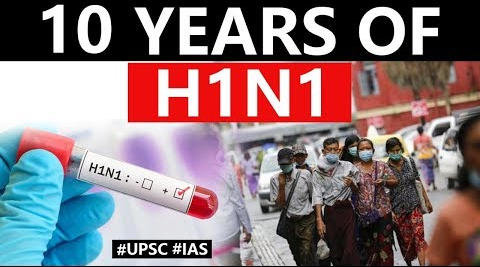Table of Contents
- H1N1 virus is sometimes mentioned in the news with reference to which one of the following diseases?
- (a) AIDS
- (b) Bird flu
- (c) Dengue
- (d) Swine flu
WHAT IS H1N1?
- It is commonly known as Swine influenza.
- It is a respiratory infection common to pigs worldwide caused by type A influenza viruses.
- Type A influenza viruses has subtypes H1N1, H1N2, H2N1, H3N1, H3N2, and H2N3.
- The swine influenza virus can be transmitted to humans via contact with infected pigs or environment contaminated with virus.

10 YEARS OF H1N1
- In April 2009, the first case of influenza A H1N1 was reported in Mexico.

- Later the infection spread and a total of 214 countries were affected by the pandemic worldwide.


- Ten years since, influenza H1N1 has become a seasonal virus, according to the Centers for Disease Control (CDC) in Atlanta.
- Yet, in India, the past decade saw as many as 1.58 lakh persons being infected by the virus and over 10,000 succumbing to it.
REASONS FOR RAPID SPREAD IN LAST 10 YEARS
- The virus changes its pattern and comes in a stronger form every alternate year.
- Climate change is making it more difficult in controlling the disease.
- Less rain and more wind leads to quick spread of the virus.
- Lack of awareness. (lab check)
DIFFERENT PATTERN IN VIRUS
- In temperate countries, influenza activity peak is recorded in winters.
- Whereas, in the tropical and sub-tropical countries, the primary peak of influenza activity is during the monsoon.
- However, in some places, influenza also peaks during winters and in some tropical countries, influenza sustains throughout the year.
H1N1 STATUS IN INDIA?
- Maharashtra has reported the highest number of cases (33,284) and deaths (3,637) since pandemic influenza struck in 2009.
- In 2019 Rajasthan is the worst hit with 5,040 cases and 206 deaths.
- This year Gujarat has also reported 4,819 cases and 149 deaths.
CURIOUS CASE OF 2017

- Before 2017, cases used to come mainly from western parts of India and localised to districts like Pune in Maharashtra and Jaipur in Rajasthan
- But after 2017 even northeastern states like Arunachal Pradesh and Tripura, which had never reported influenza A (H1N1) cases in the past, notified 44 cases in 2017.
- This year, Tripura registered 31 cases, Sikkim reported 8, while Meghalaya and Manipur reported 2 each.
CONCLUSION
- There is a need to have a detailed research & study to understand the changing pattern of swine influenza virus.
- Also, the testing of virus at early stage is the key to reduce the deaths due to swine flue.
Latest Burning Issues | Free PDF






















 WhatsApp
WhatsApp